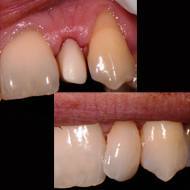FIXED PROSTHESIS
Its function is to replace lost or compromised teeth for functional and/or aesthetic purposes. Prosthetic dentistry is also the part of dentistry that deals with the design and construction of prosthesis with the help of dental technicians, subject to the following requirements:
Functionality:concerns the restoration of the proper chewing and joint function (open, close, right-left laterality, protrusion-retrusion and correct phonetics).
Resistance: the prosthesis must be resistant to masticatory forces and wear.
Bio-compatibility: the prosthesis must be constructed from materials that are non-toxic and without “corners” that could damage the tissues, causing long-term serious illnesses.
Aesthetics: artificial teeth should be as similar as possible to the natural ones and care must be taken not to alter the correct facial profile of the patient.
They are applied on the prepared teeth by the dentist (abutments), reducing them in height and volume, and by cementing the prosthesis on them, which has the same shape and function as the natural tooth.
Metal-resin crowns and bridges
They have an internal structure made of dental alloy (gold or not), coated with a properly moulded composite resin, hardened at room temperature and under pressure, to make the material more compact.
Metal-ceramic crowns and bridges
They have an internal structure made of dental alloy (gold or not), coated with an opaque layer in order not to do reveal the colour of the metal and the ceramic, which is treated in specific ovens for ceramics, is layered on this. The high temperature will transform the earthy mixture in a glassy substance that will be very tough and resistant to abrasion and acids in the mouth. Among the advantages of the ceramic, the most important is the stability of the shape and colour over time.
Temporary crowns in resin and bridges in reinforced resin
They are attached to the tooth or implant during the processing period of the final crown or bridge or while waiting for any healing. Although they are temporary, the functional value of the provisional crown or bridge is very important. The temporary crown is needed to protect the tooth from thermal stimuli when it is not devitalized but it has been dimensionally reduced before the final restoration. It also serves to protect the tooth from bacteria that can penetrate through the open dentinal tubules, causing a nerve inflammation (pulpitis), not to feel discomfort while eating throughout the treatment period and to avoid its tilt due to the lack of contact points. The temporary crown is also used to prevent the overgrowth of the gum around the prepared tooth. In case of several prepared teeth and to withstand masticatory forces for a very long period, the provisory elements can be reinforced by a metal structure: provisionally armed in this case.
Ceramic veneers
Today it is possible to correct small crown misalignments, discoloration or imperfections of anterior teeth without having to undergo prosthetic treatment which requires reducing the volume of the tooth. The preparation consists in the reduction of a couple of millimetres of the anterior and occlusal surface of the tooth and after treating the surface, thin films called veneers are applied made from ceramic material and prepared in the laboratory on a mould made from the patient’s impression. The result is definitely amazing.

